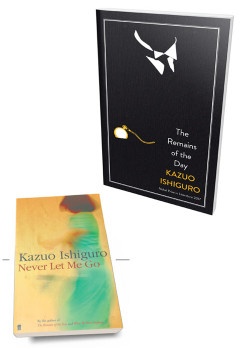THE REMAINS OF THE DAY and NEVER LET ME GO
THE REMAINS OF THE DAY and NEVER LET ME GO
Kazuo Ishiguro (Faber and Faber)
British author Kazuo Ishiguro has become one of the most celebrated authors of the modern age. Most notably, he won the Nobel Prize for Literature in 2017, one of the most revered literary prizes in the world. The achievement followed nearly four decades of accolades and prizes for his work, including the Man Booker Prize for Fiction in 1989 for his third novel, The Remains of the Day, and being named as one of the greatest writers in the past century by Time in 2010, for his work Never Let Me Go.
Upon his selection, the Nobel Prize Committee said that Ishiguro had been chosen for the award due to his “great emotional force” as a writer, who has through his work “uncovered the abyss beneath our illusory sense of connection with the world”.
Perhaps rather self-deprecatingly, Ishiguro has said that when his agent called him to say that he had won the award, his first thought was that the announcement could be “fake news”. Ishiguro then went on to say that he hoped his win would be something which “engenders goodwill and peace” and served as a reminder of “how international the word is”.
Indeed, Ishiguro – who was born in Japan and moved to the UK when he was five years old – has previously suggested that his international upbringing gave him a unique perspective of England, where many of his stories are set. “I don’t have a deep link with England like, say, Jonathan Coe or Hanif Kureishi might demonstrate. For me, it is like a mythical place,” he said. One that perhaps seems even more surreal for Ishiguro after he was made a Knight of the Realm in his adopted country, for his achievements in literature, in June 2018.
Although it was first published in 1989, Ishiguro’s Booker Prize-winning novel The Remains of the Day arguably still remains a relevant and immediate piece of literature three decades later. The plot addresses the universal themes of love, honour and sacrifice and is told through the first-person diary entries of the lead character, a butler named Stevens.
Set in the summer of 1956, we learn that Stevens has worked as the chief of staff at an English country estate called Darlington Hall for several decades, which has recently come under the ownership of an American named Mr Farraday. We discover that the estate’s previous owner (and Stevens’ former employer) Lord Darlington was a Nazi sympathiser, and as a result died in disgrace following the end of World War Two. The plot takes us on a journey over several decades in which we discover the moral choices Stevens has had to make – and live with – while in Lord Darlington’s servitude. Indeed, it seems that despite Stevens’ best efforts over the years to carry out his work with dignity and pride, it is hard to separate the character from the atrocities connected with his former employer.
As Stevens comes to terms with his relationship with Darlington Hall’s former owner, we also learn of the personal sacrifices the butler has made during his tenure with the Darlington family, most poignantly his unspoken love for a former colleague, Miss Kenton.
Upon his selection, the Nobel Prize
Committee said that Ishiguro had
been chosen for the award due to his
“great emotional force” as a writer,
who has through his work “uncovered
the abyss beneath our illusory sense of
connection with the world”
Perhaps the most powerful part of Ishiguro’s method of storytelling in The Remains of the Day is the immediacy of his first-person narrative. While the reader might question the reliability of the narrator, the subtlety of Ishiguro’s storytelling raises the idea that the thought stream of Stevens’ diary is as much about the character trying to create self-preserving narratives about his past, as it is about relaying details of his present. Central to the plot is the battle between Stevens’ desire to be proud of his work and sacrifice versus his feelings of being imprisoned by irreversible, unredeemable regret.
In a similar light to his earlier novel, in Never Let Me Go Ishiago introduces a first-person narrator reflecting on their life. Unlike Stevens however, who is nearing old age at the start of The Remains of the Day, Ishiago’s 2005 novel is narrated by a character named Kathy, who we are told is 31-years-old. The plot explores the idea of mortality, and specifically what happens to an individual when they realise their time on earth is limited.
Based in England, the plot follows Kathy and her childhood friends, Tommy and Ruth, through their school years at Hailsham School to the present day. We learn that while growing up, the school had a distinct interest in keeping pupils physically healthy, with not much care for their academic development. As the plot develops, we discover that the academy is no ordinary school, and is in fact a home for cloned children, who will be used as organ donors in their twenties and thirties.
The children are brainwashed in to believing they have a “special purpose” and kept separate from mainstream society. In Never Let Me Go, the author raises uncomfortable questions about what society as a whole is willing to ignore, especially when it’s in its self-interest to do so, along with questions of mortality: what becomes important when a person realises that they will soon die?
The answer from Ishiago, as always, appears as seemingly complex as it is simple: making sure those we love know that we care, and putting right what or who we have wronged.
NOBEL MUSEUM 2019
Under the title ‘Sharing Worlds’, this year’s Nobel Museum organised by the Mohammed bin Rashid Al Maktoum Knowledge Foundation celebrates the Nobel Prize in Literature. Focusing on the work of selected Nobel laureates in literature, and featuring an interactive exhibition suitable for all ages, the Museum runs from 3 February to 2 March, at La Mer, in Dubai. The Museum is open Sunday to Thursday, 9am – 10pm, and Friday, 2pm – 10pm.








